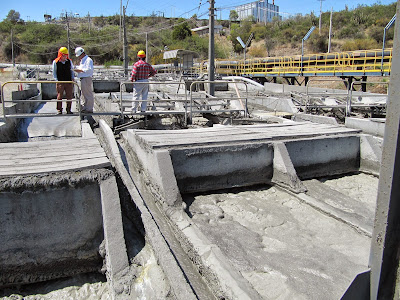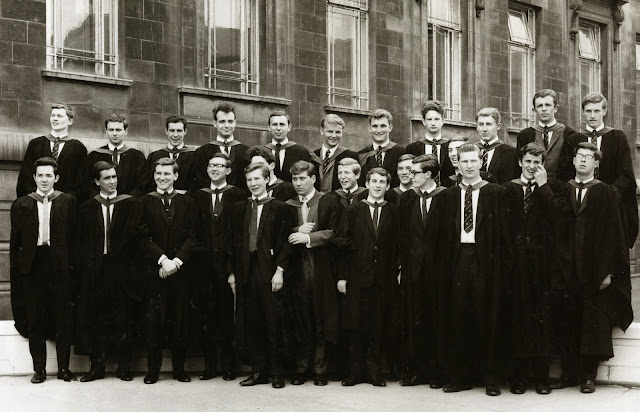Gecamin's Procemin '13 was held at the Sheraton Hotel, Santiago, Chile from October 15-18. Founded in 1998, Gecamin organises highly technical, international seminars and conferences that focus on generating interdisciplinary collaboration within the mining industry. Procemin '13 was the 10th in Gecamin's series of international mineral processing conferences.
MEI is one of the six media partners, and I am here mainly to meet people and provide an overview, so I hope that my notes will be supplemented by comments from attendees.
Tuesday 15th October
Procemin began today with an optional visit to Minera Valle Central, which processes current and old tailings from the giant El Teniente copper mine (see
posting of October 15th).
 |
| Minera Valle Central, showing old El Teniente tailings and the 40 km launder on the right carrying fresh tailings |
After registration and opening speeches in the evening there was a welcoming reception, and a big screen viewing, courtesy of Metso, of Chile's 2-1 defeat of Ecuador, to qualify for next year's World Cup. Hopefully a good omen for the next few days!
It was good to meet Carlos Barahona, the General Manager of Gecamin, and his daughter Carolina, Communications Coordinator, and to discover that, like MEI, Gecamin is also a family business. Probably why they run such well organised events!
 |
| With Carlos and Carolina Barahona of Gecamin |
Wednesday 16th October
I had breakfast this morning with Procemin's Technical Director
Romke Kuyvenhoven, who was pleased to hear my views on yesterday's field trip. She is considering including this in the programme for next year's
IMPC, also organised by Gecamin, and if it is I would definitely advise that you reserve a place.
Romke tells me that over 380 delegates have registered for Procemin, around two thirds being from Chile. She was disappointed that the first plenary speaker was unable to attend, so the morning session started a little later than planned with a plenary talk by
John Wells, now an independent consultant from Canada.
John discussed the huge cost escalation that has occurred in the first 12 years of the 21st century. Project capital costs have been reported to have doubled, tripled or even quadrupled in this time period. This has rendered many projects to be no longer economically viable and has caused a crisis in the industry. He provided some ideas and suggestions in which capital costs might be reduced and control of capital costs improved.
The second plenary was presented by Gustavo de la Torre of Milpo, Peru, who discussed the application of safe and socially responsible technology in tailings disposal at the Cerro Lindo Mine. This, as will many of the papers, was presented in Spanish, but there are excellent simultaneous translation facilities at the conference.
 |
| Chris Greet and Bill Skinner (Australia) share a joke with Cyril O'Connor |
After the coffee break the programme split into parallel sessions, on
Project Development, and
Fundamentals of Flotation. The latter included a paper by
Kari Heiskanen, who will be presenting the keynote lecture in the Fundamentals symposium of
Flotation '13 next month.
The long afternoon programme contained four technical sessions, comminution dominating with a session on High Pressure Grinding and one on comminution equipment and media wear. The former contained two presentations by
Chris Morley of Ausenco Services on equipment selection for HPGR-based comminution and two papers from Metso, a major supplier of HPGR.
 |
| Chris Morley (2nd right) with Dariusz Lelinski at the FLSmidth booth |
Laboratory testing and flotation scale up was the theme of the 3rd session, with papers from Australia, Canada, South Africa and Mexico. The 4th session contained a discussion panel on the theme of tailings filtration and dry stacking.
The day ended with an open IMPC Committee, where plans for next year's event in Santiago were outlined by Chairman Juan Yianatos. It is expected that over 1000 delegates will be here for the IMPC and over 800 abstracts from 44 countries have already been received!
Thursday 17th October
The IMPC created a commission on education a few years ago to study the supply and demand of mineral processors worldwide. Jan Cilliers of Imperial College, UK, chaired this commission and this morning he presented an excellent keynote lecture on the study's findings, which have also been published in book form and will soon be available for download on the internet. I will post further details on this in a later blog.
 |
| Jan Cilliers (2nd left0 at the FLSmidth booth |
Although the report contains much speculation on the demand side, it is obvious that the supply chain is slow and long term needs must be considered and planned for, a difficult task considering the unpredictable and cyclic nature of the industry.
Jan has presented the findings at a number of recent conferences, but each time the data has been refined, such that now it is a very useful guide to the global situation with some very surprising findings. Western Europe, for example, produces only 50 graduates per year, compared with China's 2920!
In his IMPC update yesterday
Juan Yianatos noted that the major areas for abstract submission were, unsurprisingly, flotation and comminution, and today's parallel sessions focused on these important areas.
 |
| John Starkey with Chile's Claudia Velasquez |
In the morning session, on comminution process modelling, SAG mills and stirred mills, which have become increasingly used over the last few decades, were highlighted. Metso, who manufacture one of the most widely used stirred mills, provided a review of their Vertimill pilot plant operation for grinding studies. There are over 430 Vertimills in operation worldwide.
Metso is one of the sponsors of
Comminution '14, as is Starkey & Associates, Canada and
John Starkey presented an interesting paper on optimising the design of SAG mills in order to achieve design tonnage from start-up.
The other parallel session this morning was on the theme of flotation plant optimisation, with papers from Chile and Australia.
 |
| Demonstration of the Imhoflot G cell |
A very interesting panel discussion on fine grinding took place after lunch, with short technical presentations from some of the big players in this field, Metso, Xstrata Technology, Outotec and Glencore Peru.
Brian Knorr of Metso USA provided a short update on Metso stirred milling technologies. The Vertimill is a gravity-induced stirred mills and can grind well to about 20 microns, mainly for regrinding applications. The Stirred Media Detritor is a fluidised stirred mill used for very efficient fine and ultrafine grinding below 20 microns, but they are very sensitive to conditions. Metso is in the midst of a 3 year programme with JKMRC to optimise and validate current selection methods.
Karina Arburo discussed fine grinding from an Xstrata Technology perspective. She talked about assessment of the best testing method for energy and scale up in IsaMills and that fine grinding requires fine media using attrition, not impact.
Dante Garcia of Glencore Peru discussed fine grinding in stirred mills from an operational point of view. Using IsaMills it was found that rounded media is more efficient than angular media, and lighter media was more efficient for fine grinding. Although fine grinding improves liberation, floatability is reduced at fine sizes, so a compromise on flotation size must be made. He considered that flow control and adequate maintenance are the main factors in successful regrinding using stirred mills.
Ilkka Roitto of Outotec, Finland, then showed how to control regrinding to reach optimal process results and energy efficiency.
 |
Jim Finch with ex-McGill students Rodrigo Araya of Xstrata Technology,
Canada, and Willy Kracht of University of Chile |
This panel discussion, which emphasised the importance of circuit control, unfortunately ran in parallel with another relevant session on simulation and control, then after the coffee break there were parallel sessions on concentrator management and operations, and waste management.
 |
| With Hanl Long and Sun Chuanyao of BGRIMM |
A very long day gave us just an hour to freshen up before the evening cocktail reception and dinner. This was a superb event with great food and company. Among the interesting people on my table were the IMPC's Chinese representative,
Sun Chuanyao, and
Han Long, both of the Beijing General Research Institute of Mining and Metallurgy. Han organised the
marvellous dinner at the Beijing IMPC in 2008, an event almost impossible to follow, although this evening's entertainment, provided by
Projectango was of the highest quality:
 |
IMPC Chairman Cyril O'Connor with conference organisers
Fabiola Bustamante, Romke Kuyvenhoven and Carlos Barahona |
Friday 18th October
An interesting plenary lecture this morning was presented by Jeffrey Dawes of Komatsu, Chile. Over the last few years a tendency has developed to outsource specific aspects of the mining process to the respective 'experts', such as is the case for equipment maintenance and repair services. While this makes perfect sense in terms of optimising resources and sharing risk, the fact that each of the different players in the production chain are looking to maximise their own individual result does raise the question of whether all have the same objective. Considering the extent of instant communications that exist today, resulting in the possibility of organising massive events in a matter of hours, communication between the different parties in the mining value chain surely can be improved, in order to optimise the process both for the process owner, the mining company and their suppliers.
John Herbst of Metso Minerals, USA presented the second plenary, showing how advanced modelling and simulation methods have evolved over the last half century. In the last 50 years prediction errors for advanced mineral processing models have been reduced from about 20% to less than 1%; if computer developments continue and gifted investigators from a variety of disciplines see the value of joint efforts, then strong advancements will continue to occur.
There were two very interesting sessions after the coffee break, but unfortunately running in parallel. Geometallurgy is the latest edition to the mineral processing lexicon and has already been the subject of a
major conference this year, and is an integral part of MEI's
Process Mineralogy '14.
Romke Kuyvenhoven chaired a panel discussion on geometallurgy, which ran in parallel with a session on flotation equipment.
The world's largest flotation cell will soon be installed and tested by FLSmidth at a mine in USA. The 600 Series SuperCell will be used as a rougher-scavenger in the copper flotation circuit.
Flotation '13 keynote speaker
Dariusz Lelinski described how CFD models of existing cells were used to develop these huge cells, the volume of which varies from 600 to 700 m3 depending on launder configuration. Other papers in this session discussed the use of flotation columns, Jameson Cells and forced-air flotation machines.
This has been an excellent conference, in terms of networking and quality of papers. The papers are available in a Proceedings volume (ISBN 978-956-8504-99-1) from
Gecamin.
I congratulate the organisers on their professionalism. It has been my first Procemin conference, but it will not be my last! I now look forward to returning to Santiago next year for the IMPC, which I feel is in safe hands with Gecamin as organiser under the chairmanship of Santa Maria University's Juan Yianatos.































































-EDIT.jpg)




